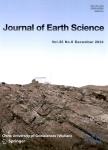Paleomagnetism of Cretaceous Red beds from Eastern Part of South China Block
Paleomagnetism of Cretaceous Red beds from Eastern Part of South China Block作者机构:Department of Global Tectonics Faculty of Science Himeji Institute of Technology Shosha 2167 Himeji 671-2201 Japan School of Humanity for Environment Policy and Technology Himeji Institute of Technology Shinzaike-Honmachi 1-1-12 Himeji 670-0092 Japan Faculty of Business Administration Southern Osaka University Hirao 1060-1Mihara-cho Minami-Kawachi-gun 587-8555 Osaka Japan Faculty of Science Kobe University Rokkodai-cho 1-1 Nada 657-8501Kobe Japan
出 版 物:《Journal of Earth Science》 (地球科学学刊(英文版))
年 卷 期:1999年第18卷第3期
页 面:258-264页
核心收录:
学科分类:070801[理学-固体地球物理学] 07[理学] 0708[理学-地球物理学]
基 金:Grant-in-Aid for International Scientific Research (University-to-University Cooperative Research) from the Japanese Ministry of Education, Science, Sports and Culture(07045014) Grant-in-Aid from Hyogo Science and Technology Association(10H10)
主 题:Late Cretaceous red sandstone paleomagnetism virtual extrusion tectonics geomagnetic pole South China block (SCB)
摘 要:We performed on paleomagnetic investigation of the Upper Cretaceous red sandstones collected from Fujiau and Guangdong provinces. Significant characteristic directions were isolated by principal comPonent analysis from 22 of 25 and 9 of 14 sampling sites iu Fujian and Guangdong,respectively. Maximum concentration of global mean directions every province is achieved at 70 %and complete (100 % ) untilting for Fujian and Guangdong, respectively. We regarded these mean directions as the Late Cretaceous paleomagnetic directions and calculated virtual geomagnetic poles (VGPs); Fujian, Lat. /Lon. = 79. 4°N/210. 3°E (α95= 5. 1°) and Guangdong, Lat. /Lon. = 80. 1°N/193. 4°E (α95=8. 0°). These two VGPs are nearly equal to each other and to a mean VGP from Sichuan Province reported previously. This observation suggests no relative movement among three regions, Fujian, Guangdong and Sichuan, since the Late Cretaceous. Two VGPs from this study are significantly different from previously reported VGPs from the same regions. Further systematic paleomagnetic works are needed to clarify this difference of VGP Positions.



